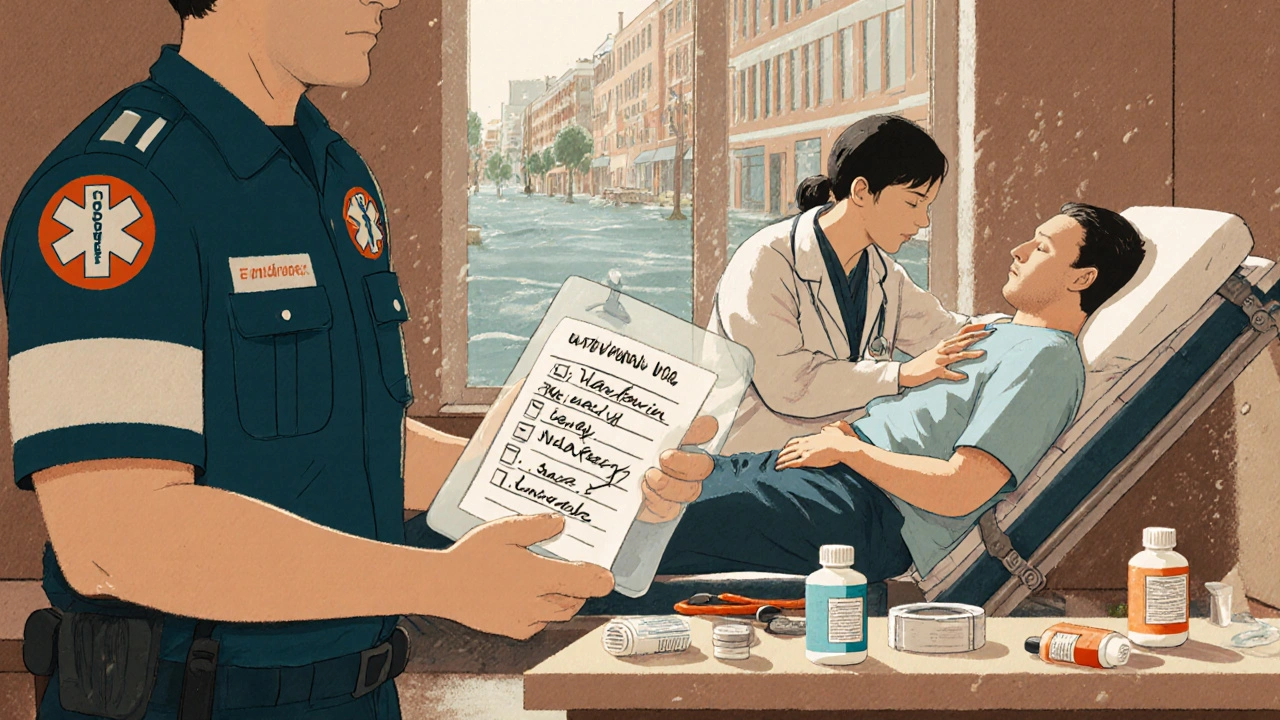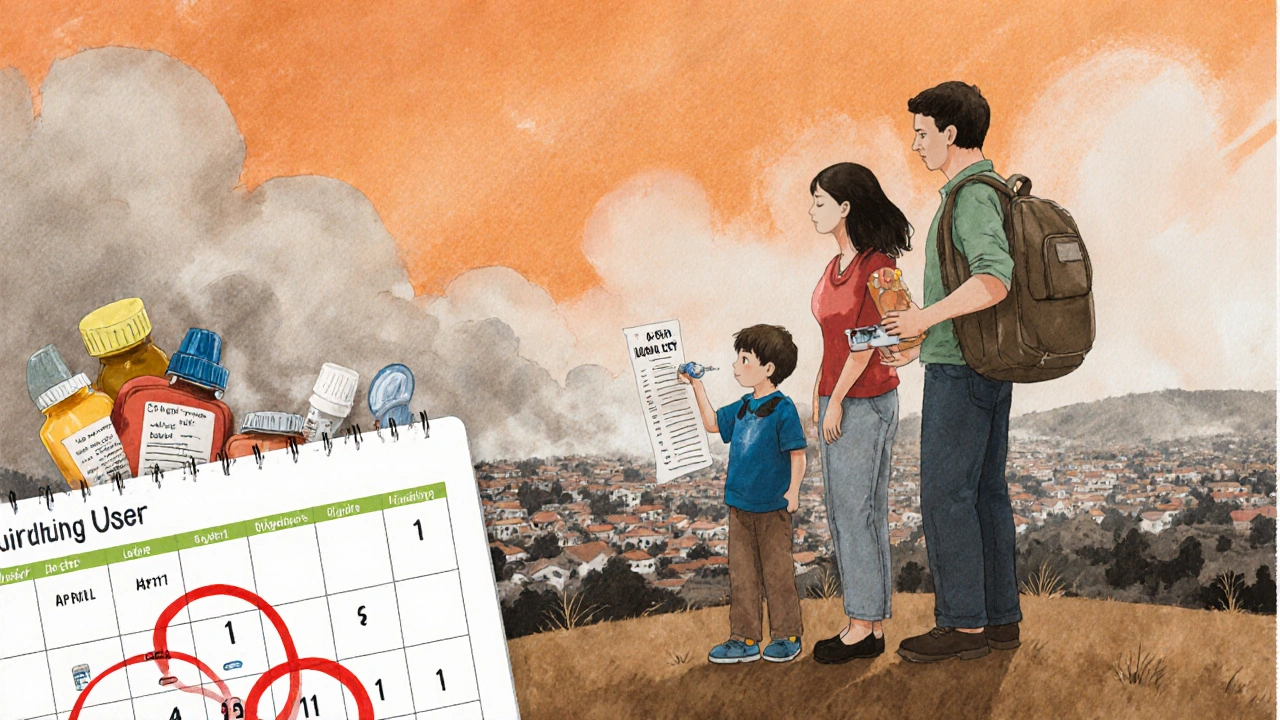Why Your Medication Go-Bag Could Save Your Life
Imagine this: You’re told to leave your home in 10 minutes. The floodwaters are rising. The fire is closing in. You grab your wallet, your phone, your keys. But what about your blood pressure pills? Your insulin? Your inhaler? If you don’t have them, you’re not just inconvenienced-you’re at risk. Emergency responders can’t always reach you right away. Pharmacies might be closed. Power outages can ruin your meds. This isn’t hypothetical. In 2022, the CDC found that 38% of emergency room visits during disasters were tied to people running out of essential medications. Cardiovascular drugs made up nearly a third of those cases. You don’t need to be elderly to be at risk. One in five Americans has a chronic condition requiring daily medication. If you’re one of them, your go-bag isn’t optional. It’s survival gear.
What Goes Into a Real Medication Go-Bag
A medication go-bag isn’t just a shoebox of pills. It’s a carefully planned kit designed to keep you alive and stable when everything else falls apart. The standard recommendation from FEMA and the American Red Cross is a seven-day supply of all your essential medications. But here’s the catch: that’s the bare minimum. In places like California or Florida, where disasters can trap people for weeks, experts like Alert San Diego recommend a two-week supply. Don’t wait until the sirens blare to start packing. Start now.
- Prescription meds: All medications you take daily-blood pressure, diabetes, thyroid, antidepressants, seizure drugs. Don’t forget rescue meds like albuterol inhalers or epinephrine auto-injectors.
- Over-the-counter essentials: Pain relievers (acetaminophen, ibuprofen), antidiarrheal, antihistamines, antacids, and laxatives. These aren’t luxuries-they’re necessities when you can’t get to a store.
- Specialty items: If you use insulin, injectables, nebulizers, or oxygen, include those. Insulin needs refrigeration. If your power goes out, your meds could spoil. Use a Frio Wallet or similar cooling case, tested to keep insulin below 86°F for up to 48 hours.
- Medical devices: Glucometers, blood pressure cuffs, CPAP machines (with battery backups), hearing aids with extra batteries.
And here’s something most people miss: keep everything in original containers. Pharmacists and ER staff need to see the label-dosage, name, prescribing doctor. A pill organizer might be convenient at home, but in an emergency, it’s useless if no one knows what’s inside.
The Document That Could Prevent a Medical Mistake
Medications aren’t just pills. They’re instructions. And those instructions need to travel with you.
Westchester County Emergency Services says your go-bag must include: “a list of the medications you take, why you take them, and the dosages.” That’s not optional. It’s critical.
Write it out. Don’t rely on your phone. Power outages happen. Phones die. Print this list and put it in a waterproof pouch. Include:
- Full name and date of birth
- Primary care doctor’s name and number
- Allergies (especially to antibiotics, NSAIDs, or sulfa drugs)
- Chronic conditions (diabetes, heart failure, COPD, epilepsy)
- Current dosages and times you take them
- Emergency contacts (family, pharmacy, caregiver)
- Advance directives or DNR orders, if applicable
One woman in Halifax, who evacuated during a flash flood in 2023, credits this list with saving her life. Emergency staff saw she was on warfarin and avoided giving her ibuprofen-a deadly combo. That detail was on her paper list. Her phone was in the water.

How to Keep Your Meds Safe (and Effective)
Storing your meds wrong can turn your go-bag into a hazard.
Consumer Reports and the CDC agree: keep your go-bag in a cool, dry place. Not the bathroom. Not the garage. A high shelf in your bedroom closet works. Avoid humidity and heat-they degrade pills and make insulin useless.
Temperature-sensitive meds like insulin, epinephrine, or certain antibiotics need special care. A Frio Wallet or similar evaporative cooling case is worth the investment. These are tested to keep meds below 86°F for up to two days without ice. If you use a refrigerated medication, get a small cooler with reusable gel packs. Rotate them monthly.
And check expiration dates. Twice a year. Set a reminder on your phone: April 1 and October 1. Expired epinephrine can fail to work. Old antibiotics might not kill the infection. Expired seizure meds? That’s not a risk you can afford.
Don’t Wait Until the Last Minute
Geoffrey C. Wall, Pharm.D., from Drake University, says it plainly: “Don’t wait until you’re faced with the need to leave your home in a hurry to assemble your go-bag.”
Here’s how to build it without stress:
- Start with your list. Write down every medication you take, including supplements and OTCs.
- Call your pharmacy. Ask if you can get a 60- or 90-day supply instead of 30 days. Most insurers allow this for maintenance meds. Ask for extra refills before hurricane season or wildfire risk periods.
- Fill prescriptions on day one. Don’t wait until you’re out. Fill your script the day you’re eligible. That gives you a buffer.
- Rotate your stock. When you use a pill from your go-bag, replace it immediately. Don’t wait for the next refill. Keep your supply fresh.
- Test your kit. Pack it up. Carry it around the house. Does it fit in your car? Can you grab it in the dark? Make sure it’s easy to access.
It takes 2-3 tries to get it right. Don’t expect perfection on the first try. Just start.

What You Shouldn’t Include
Less is more. Your go-bag should be light enough to carry for a mile if needed. Skip these:
- Extra clothes (unless it’s freezing-then add one thermal layer)
- Non-medical electronics (save your laptop for later)
- Large bottles of water (you’ll get water at shelters; focus on meds)
- Unlabeled pills
- Medications you don’t currently take
And never pack expired meds. Even if they look fine. Epinephrine auto-injectors lose potency fast after expiration. In a cardiac arrest, that could be fatal.
Special Cases: Kids, Seniors, and Complex Regimens
Children with asthma, seniors on five or more meds, or people on biologics face unique challenges.
For kids: Include a printed list of all medications, allergies, and pediatrician info. Keep liquid meds in sealed, leak-proof containers. Add a syringe or dosing cup.
For seniors: 89% of people over 65 take at least one prescription. Many are on blood thinners, diuretics, or heart meds. These can’t be skipped. Keep a copy of their most recent lab results (INR, creatinine) if available.
For complex regimens: If you’re on injectables, infusions, or require refrigeration, talk to your pharmacist. Ask if they offer emergency supply programs. Some pharmacies in Nova Scotia and Ontario now keep backup doses for patients with chronic conditions.
The Bigger Picture: Why This Matters
After Hurricane Katrina in 2005, the U.S. realized its emergency system failed people on chronic meds. Since then, the number of households with emergency kits has jumped from 39% to 58%. But only 22% have adequate medication supplies. That’s a gap. And it’s deadly.
Climate change is making disasters more frequent. The National Academy of Medicine predicts a 40% rise in weather-related evacuations by 2030. That means more people will need their meds on the move. The CDC is already working on condition-specific go-bag templates for diabetes and heart disease-coming in early 2024.
Technology is helping too. Devices like the MedAngel ONE monitor temperature inside your go-bag and alert your phone if meds are getting too hot or cold. It’s FDA-cleared. It costs less than a month’s co-pay.
This isn’t about being prepared for the worst. It’s about ensuring your health doesn’t become another casualty of chaos.
What if I can’t get a 14-day supply of my meds?
Start with at least a 7-day supply. Then, talk to your pharmacist. In 42 U.S. states and some Canadian provinces, pharmacists can give you an emergency supply of most maintenance meds without a new prescription during a declared emergency. Ask them what’s allowed in your area. You can also request early refills before hurricane or wildfire season.
Can I just keep my meds in my car?
No. Cars get too hot in summer and too cold in winter. Insulin, epinephrine, and many other meds can degrade quickly in extreme temperatures. Store your go-bag inside your home-in a closet or drawer, away from kids, and out of direct sunlight. If you must keep a small backup in your car, use a temperature-controlled case and check it monthly.
Do I need to carry all my meds if I’m only evacuating for a day?
Yes. Emergencies can last longer than expected. Power outages, blocked roads, or shelter overcrowding can delay your return. Even if you think you’ll be back in 24 hours, assume you’ll be away for at least 72 hours. It’s better to have extra and not need it than to run out and end up in the ER.
What if I use insulin? How do I keep it cold?
Use a Frio Wallet or similar cooling case-it works without ice or electricity. It keeps insulin below 86°F for up to 48 hours. If you’re going somewhere with power, bring a small cooler with frozen gel packs. Rotate the packs every few weeks. Never store insulin in a freezer or direct sunlight. Check the label: once opened, most insulin lasts 28 days at room temperature, but heat ruins it faster.
Should I include vitamins and supplements?
Only if they’re part of your medical treatment. For example, if you’re on high-dose vitamin D for a diagnosed deficiency, include it. But general multivitamins? Skip them. Focus on prescription and essential OTC meds. Your go-bag should be small and focused. Every extra item takes up space you might need for more critical meds.
